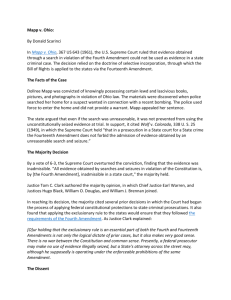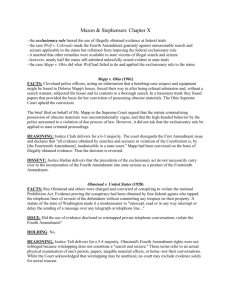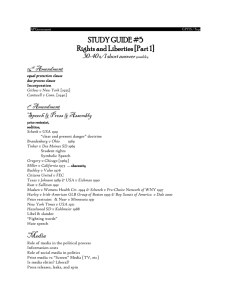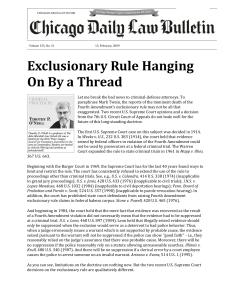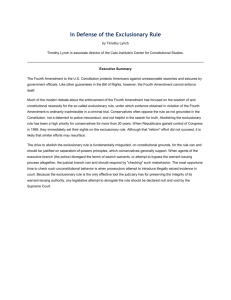Chapter #10 Notes
advertisement
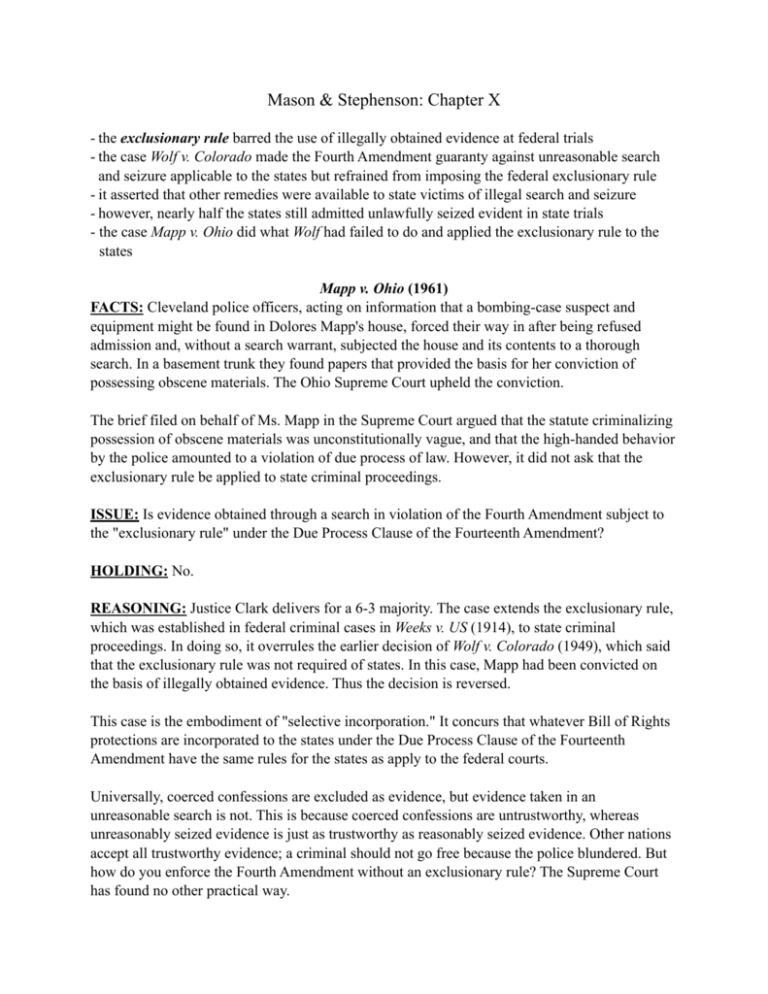
Mason & Stephenson: Chapter X - the exclusionary rule barred the use of illegally obtained evidence at federal trials - the case Wolf v. Colorado made the Fourth Amendment guaranty against unreasonable search and seizure applicable to the states but refrained from imposing the federal exclusionary rule - it asserted that other remedies were available to state victims of illegal search and seizure - however, nearly half the states still admitted unlawfully seized evident in state trials - the case Mapp v. Ohio did what Wolf had failed to do and applied the exclusionary rule to the states Mapp v. Ohio (1961) FACTS: Cleveland police officers, acting on information that a bombing-case suspect and equipment might be found in Dolores Mapp's house, forced their way in after being refused admission and, without a search warrant, subjected the house and its contents to a thorough search. In a basement trunk they found papers that provided the basis for her conviction of possessing obscene materials. The Ohio Supreme Court upheld the conviction. The brief filed on behalf of Ms. Mapp in the Supreme Court argued that the statute criminalizing possession of obscene materials was unconstitutionally vague, and that the high-handed behavior by the police amounted to a violation of due process of law. However, it did not ask that the exclusionary rule be applied to state criminal proceedings. ISSUE: Is evidence obtained through a search in violation of the Fourth Amendment subject to the "exclusionary rule" under the Due Process Clause of the Fourteenth Amendment? HOLDING: No. REASONING: Justice Clark delivers for a 6-3 majority. The case extends the exclusionary rule, which was established in federal criminal cases in Weeks v. US (1914), to state criminal proceedings. In doing so, it overrules the earlier decision of Wolf v. Colorado (1949), which said that the exclusionary rule was not required of states. In this case, Mapp had been convicted on the basis of illegally obtained evidence. Thus the decision is reversed. This case is the embodiment of "selective incorporation." It concurs that whatever Bill of Rights protections are incorporated to the states under the Due Process Clause of the Fourteenth Amendment have the same rules for the states as apply to the federal courts. Universally, coerced confessions are excluded as evidence, but evidence taken in an unreasonable search is not. This is because coerced confessions are untrustworthy, whereas unreasonably seized evidence is just as trustworthy as reasonably seized evidence. Other nations accept all trustworthy evidence; a criminal should not go free because the police blundered. But how do you enforce the Fourth Amendment without an exclusionary rule? The Supreme Court has found no other practical way. Olmstead v. United States (1928) FACTS: Roy Olmstead and others were charged and convicted of conspiring to violate the national Prohibition Act. Evidence proving the conspiracy had been obtained by four federal agents who tapped the telephone lines of several of the defendants without committing any trespass on their property. A statute of the state of Washington made it a misdemeanor to "intercept, read or in any way interrupt or delay the sending of a message over any telegraph or telephone line..." ISSUE: Did the use of evidence disclosed in wiretapped private telephone conversations violate the Fourth Amendment (under the Due Process Clause of the Fourteenth Amendment)? HOLDING: No. REASONING: Chief Justice Taft delivers for a 5-4 majority. Olmstead's Fourth Amendment rights were not infringed because wiretapping does not constitute a "search and seizure." These terms refer to an actual physical examination of tangible objects, not their conversations. Thus a warrant is not needed for a wiretap if it is made without entering the home. DISSENT: Justice Brandeis believes that the Court must look past the mere words of the Constitution, and look at its purpose. When the Framers adopted the Constitution, they were only familiar with the search and seizure of tangible objects. However, they, wanted to protect against all invasions of the individual's home and surroundings. Justice Holmes says that he is unsure whether wiretapping violated the Fourth Amendment, but the conviction should be thrown out because a statute had been violated by the federal agents. He also says that a violation of state law should always involve the exclusion of the evidence obtained through the violation. Olmstead was not directly overruled until 1967 in Katz. After Olmstead, Congress passed a law which the Court construed as outlawing wiretapping. The Court did not need to overrule Olmstead until electronic eavesdropping that did not interfere with telephone wires was developed, since this was not covered by the 1934 statute. Katz v. United States (1967) FACTS: Charles Katz was convicted of transmitting wagering information by telephone from LA to Miami to Boston in violation of a federal statute. At the trial, the government was permitted to introduce evidence gathered from attaching an electronic listening device to the outside of a public telephone booth from which he placed his calls. The Supreme Court granted certiorari to determine if the recordings had been obtained in violation of the Fourth Amendment. ISSUE: Does the Fourth Amendment protection against unreasonable searches and seizures require the police to obtain a search warrant in order to wiretap a public pay phone (under the Due Process Clause of the Fourteenth Amendment)? HOLDING: Yes. REASONING: Justice Stewart delivers for a 7-1 decision. The Court overruled the narrow "trespass doctrine" set by Olmstead by adopting Brandeis' dissent. It expands the perimeter of the Fourth Amendment beyond the home, noting that it protects people, not places. Thus what Katz seeks to preserve as private, even in a public area, may be constitutionally protected. The absence of a physical intrusion was unnecessary to bring the amendment into play. Furthermore, the government could have gotten a warrant to conduct the surveillance. The courts ruled that cases involving electronic surveillance cannot circumvent the requirement of advanced authorization upon showing probably cause; a warrant is a precondition of this kind of surveillance. DISSENT: Justice Black dissents for two reasons: (1) he does not believe that the words of the amendment will bear the meaning given them by the Court's decision, and (2) he believes it is not the proper role of the Court to rewrite the Amendment in order "to bring it into harmony with the time." The words of the first clause purport tangible items. The second clause, requiring a description of the place to be searched, implies existence. Future telephone calls do not exist, and cannot be described to a magistrate. United States v. United States District Court (1972) FACTS: During pretrial proceedings in a prosecution in the U.S. District Court for conspiracy to destroy government property, the court ordered the government to make full disclosure to one of the defendants of his conversations overheard by electronic surveillance instituted without a search warrant. The U.S. Court of Appeals denied the government's petition for a writ of mandamus to compel the district judge to vacate the disclosure order. ISSUE: Does the President have the power to authorize domestic electronic surveillance without securing prior judicial approval in the form of a search warrant? HOLDING: No. REASONING:
